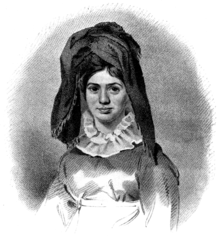- Princess Caraboo
-
Mary Baker (née Willcocks) (1791 – 24 December 1864) was a noted impostor who went by the name Princess Caraboo. She pretended to be from a faraway island and fooled a British town for some months.[2]
Contents
Biography
On 3 April 1817, a cobbler in Almondsbury in Gloucestershire, England, met an apparently disoriented young woman with exotic clothes who was speaking a language no one could understand. The cobbler's wife took her to the Overseer of the Poor who left her in the hands of the local county magistrate, Samuel Worrall, who lived in Knole Park. Worrall and his American-born wife Elizabeth could not understand her either; all they could determine was that she called herself Caraboo and that she was interested in Chinese imagery. They sent her to the local inn, where she identified a drawing of a pineapple with the word ‘ananas’, which means pineapple in many Indo-European languages, and insisted on sleeping on the floor. Samuel Worrall declared she was a beggar and should be taken to Bristol and tried for vagrancy.[citation needed]
During her imprisonment, a Portuguese sailor named Manuel Eynesso (or Enes) said he knew the language and translated her story. According to Eynesso, she was Princess Caraboo from the island of Javasu in the Indian Ocean. She had been captured by pirates and after a long voyage she had jumped overboard in the Bristol Channel and swam ashore.[citation needed]
The Worralls brought Caraboo back to their home. For the next ten weeks, this representative of exotic royalty was a favourite of the local dignitaries. She used a bow and arrow, fenced, swam naked and prayed to a god, whom she termed Allah Tallah. She acquired exotic clothing and a portrait made of her was reproduced in local newspapers. Her authenticity was attested to by a Dr Wilkinson who identified her language using Edmund Fry's Pantographia and stated that marks on the back of her head were the work of oriental surgeons.[citation needed]
Eventually the truth came out. A certain Mrs. Neale recognised her from the picture in the Bristol Journal and informed her hosts. The would-be princess was actually a cobbler's daughter, Mary Baker (née Willcocks) from Witheridge, Devon. She had been a servant girl in various places all over England but had not found a place to stay. She had invented a fictitious language out of imaginary and gypsy words and created an exotic character. The strange marks on her skin were the scars from a crude cupping operation in a poorhouse hospital as a child. The British press had a field day at the expense of the duped rustic middle-class.[citation needed]
Her hosts arranged for her to leave for Philadelphia and she departed 28 June 1817. In the USA, she briefly continued her role, but lost contact with the Worralls after a couple of months.[citation needed]
There was a contemporary legend that she had visited Napoleon imprisoned on the island of Saint Helena, but that is probably untrue.[citation needed]
In 1821, she had returned to Britain but her act was no longer very successful. She may have briefly travelled to France and Spain in her guise but soon returned to England and remarried. In September 1828, she was living in Bedminster with the name Mary Burgess and gave birth to a daughter the next year. In 1839, she was selling leeches to the Bristol Infirmary Hospital. She died on 24 December 1864 and was buried in an unmarked grave in the Hebron Road cemetery in Bristol.[citation needed]
Film
The hoax was the basis of the 1994 film Princess Caraboo, written by Michael Austin and John Wells, which added some fictional incidents to the true story.
Notes
- ^ a b Baring-Gould, Sabine (1908). "Caraboo". Devonshire Characters and Strange Events. London: John Lane. pp. 35—47. http://en.wikisource.org/wiki/Devonshire_Characters_and_Strange_Events/Caraboo.
- ^ Dictionary of National Biography. Oxford University Press . 2004. http://www.oxforddnb.com/view/articleHL/41062?docPos=1&anchor=match.
References
- John Wells. Princess Caraboo: her true story (1994), ISBN 0-330-33630-4
External links
- John Mathew Gutch. Caraboo: A Narrative of a Singular Imposition, at http://www.resologist.net/carabooa.htm
- Mary Willcocks & the Princess Caraboo Hoax: Comprehensive article on the Mysterious People website
- Princess Caraboo: Article at the Museum of Hoaxes.
Categories:- 1791 births
- 1864 deaths
- Impostor pretenders
- History of Bristol
- Fictional princesses
- People from North Devon (district)
- Hoaxes in the United Kingdom
Wikimedia Foundation. 2010.



